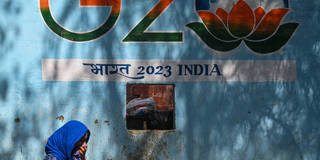Indian authorities are downplaying inconvenient macroeconomic facts so that they can celebrate seemingly flattering headline figures ahead of hosting the G20 summit. But in covering up the growing struggles faced by the vast majority of Indians, they are playing a cynical and dangerous game.
PRINCETON – Behind the billboards in Delhi advertising this month’s G20 summit are slums whose residents can no longer earn a living. Their roadside stalls and shops have been demolished, lest they tarnish Prime Minister Narendra Modi’s carefully curated image of a rising India.
India’s GDP statistics are also on display as part of this “branding and beautification” exercise. With an annual growth of 7.8% in the second quarter of this year, India appears to be the world’s fastest-growing major economy. But, again, behind the billboards are human struggles on a massive scale. Growth, in fact, is low, inequalities are rising, and job scarcity remains acute.
The G20-inspired billboards touting India’s latest GDP figure include a mysterious line about “discrepancies.” Normally an innocuous reporting convention in national accounts, the discrepancy is the difference between domestic income (earned by producing goods and services) and expenditure (what residents and foreigners pay when buying those goods and services). In principle, expenditure should equal income earned, because producers can earn incomes only when others buy their output. In practice, however, estimates of income and expenditure differ in national accounts everywhere, because they are based on imperfect data.

PRINCETON – Behind the billboards in Delhi advertising this month’s G20 summit are slums whose residents can no longer earn a living. Their roadside stalls and shops have been demolished, lest they tarnish Prime Minister Narendra Modi’s carefully curated image of a rising India.
India’s GDP statistics are also on display as part of this “branding and beautification” exercise. With an annual growth of 7.8% in the second quarter of this year, India appears to be the world’s fastest-growing major economy. But, again, behind the billboards are human struggles on a massive scale. Growth, in fact, is low, inequalities are rising, and job scarcity remains acute.
The G20-inspired billboards touting India’s latest GDP figure include a mysterious line about “discrepancies.” Normally an innocuous reporting convention in national accounts, the discrepancy is the difference between domestic income (earned by producing goods and services) and expenditure (what residents and foreigners pay when buying those goods and services). In principle, expenditure should equal income earned, because producers can earn incomes only when others buy their output. In practice, however, estimates of income and expenditure differ in national accounts everywhere, because they are based on imperfect data.